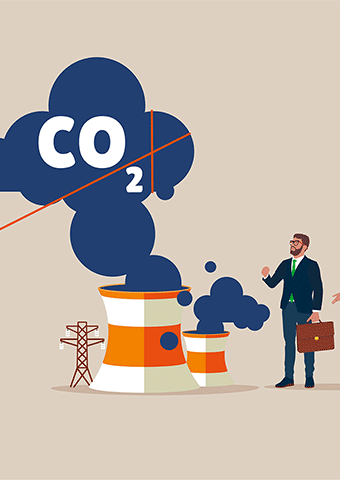
Managing the risks of missing international climate targets
The Paris targets are based on assumptions that a global temperature increase of 1.5 °C−2 °C above preindustrial levels will be safe, and that the climate can be stabilized at these higher temperatures. However, global average temperatures are already measurably impacting the Earth's systems at 1.2 °C above preindustrial levels. Many human and environmental systems cannot adapt to higher temperatures, which may exceed critical tipping points in physical climate and ecological systems. Compounding these risks is the likelihood that the international 2 °C limit will be overshot due to political obstacles and systemic inertia from existing greenhouse gases, warming oceans, and the decades required to replace existing infrastructure. Moreover, the Earth energy imbalance may have to be reduced to approximately zero to stabilize the global climate (i.e., CO2 concentrations lowered to around 350 ppm.) Most IPCC mitigation scenarios assume that climate targets will be temporarily overshot, and require large-scale carbon dioxide removal [CDR] to subsequently lower temperatures. However, many CDR methods may not be politically and/or technologically feasible, and they will act too slowly to prevent dangerous overshoot. These issues raise serious doubts about the ability of current mitigation polices to ensure safe outcomes. They also indicate the need to investigate whether rapid climate cooling measures may be required to reduce the risks associated with high temperatures during the long time it will take to decarbonize the global economy and stabilize the climate. Given the uncertainty of future mitigation success, and the potentially existential costs of failure, there is now an urgent need to examine whether or not current efforts are credible, and if not, what mitigation measures will be required to prevent dangerous overshoot and ensure a safe, stable climate. In order to develop a feasible mitigation strategy, it will be necessary to prioritize research both on climate overshoot risks, and on the relative effectiveness, risks, costs and timelines of potential mitigation and adaptation approaches. Since large scale climate interventions will be needed to prevent dangerous global warming, all plausible options need to be investigated, including carbon dioxide removal methods and technologies for rapidly cooling global temperatures. This research is a prerequisite for evaluating the comparative benefits, costs and risks of using, or not using, various forms of mitigation and adaptation, and then developing a realistic overshoot risk management plan. © 2021 The Authors
ID:
2549
Authors:
Taylor, Graeme (55454318800); Vink, Sue (35615826200)
Affiliations:
School of Chemical and Biomolecular Engineering, The University of Sydney, Sydney, 2037, NSW, Australia; School of Chemistry and Physics and QUT Centre for Materials Science, Queensland University of Technology QUT, Brisbane, 4000, QLD, Australia
Journal:
Climate Risk Management
Volume:
34
Issue:
0
Year:
Resource Type:
Research article
Geographic Coverage:
Copyright:
Gold Open Access
DOI:
10.1016/j.crm.2021.100379
Open Access:
Gold Open Access
The Paris targets are based on assumptions that a global temperature increase of 1.5 °C−2 °C above preindustrial levels will be safe, and that the climate can be stabilized at these higher temperatures. However, global average temperatures are already measurably impacting the Earth's systems at 1.2 °C above preindustrial levels. Many human and environmental systems cannot adapt to higher temperatures, which may exceed critical tipping points in physical climate and ecological systems. Compounding these risks is the likelihood that the international 2 °C limit will be overshot due to political obstacles and systemic inertia from existing greenhouse gases, warming oceans, and the decades required to replace existing infrastructure. Moreover, the Earth energy imbalance may have to be reduced to approximately zero to stabilize the global climate (i.e., CO2 concentrations lowered to around 350 ppm.) Most IPCC mitigation scenarios assume that climate targets will be temporarily overshot, and require large-scale carbon dioxide removal [CDR] to subsequently lower temperatures. However, many CDR methods may not be politically and/or technologically feasible, and they will act too slowly to prevent dangerous overshoot. These issues raise serious doubts about the ability of current mitigation polices to ensure safe outcomes. They also indicate the need to investigate whether rapid climate cooling measures may be required to reduce the risks associated with high temperatures during the long time it will take to decarbonize the global economy and stabilize the climate. Given the uncertainty of future mitigation success, and the potentially existential costs of failure, there is now an urgent need to examine whether or not current efforts are credible, and if not, what mitigation measures will be required to prevent dangerous overshoot and ensure a safe, stable climate. In order to develop a feasible mitigation strategy, it will be necessary to prioritize research both on climate overshoot risks, and on the relative effectiveness, risks, costs and timelines of potential mitigation and adaptation approaches. Since large scale climate interventions will be needed to prevent dangerous global warming, all plausible options need to be investigated, including carbon dioxide removal methods and technologies for rapidly cooling global temperatures. This research is a prerequisite for evaluating the comparative benefits, costs and risks of using, or not using, various forms of mitigation and adaptation, and then developing a realistic overshoot risk management plan. © 2021 The Authors